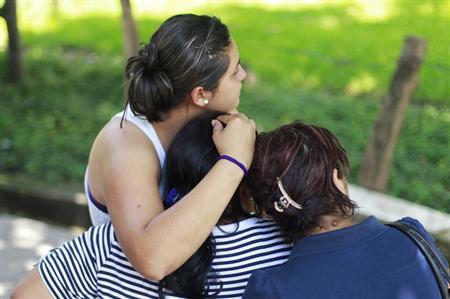El Salvador Gangs violent and murders
Reuters | Posted: 07/05/2013 10:33 pm EDT
FOLLOW:
Voces de ContraPunto, El Salvador Crime, El Salvador Deaths, El Salvador Gang Truce, El Salvador Gang Violence, El Salvador Gangs, El Salvador Homicides, El Salvador Murders, El Salvador Violence, Reuters, World News
SAN SALVADOR, July 5 (Reuters) - El Salvador has seen a burst of violence, with 103 homicides this week, the government said on Friday, as a year-long truce between the country's violent gangs appeared to be crumbling.
The uptick in murders in the Central American nation echoes killing rates before the March 2012 truce between the Mara Salvatrucha (MS-13) gang and rival Barrio 18.
"We said last year that the truce was fragile and that it could fracture in any moment. Time has proven us right," Miguel Fortin, Director of the Supreme Court's Institute of Legal Medicine (IML) told local media.
The truce, which is backed by the Catholic Church and the Organization of American States (OAS), aimed to reducing homicide rates of 66 per 100,000 inhabitants in 2011, according to the United Nations, making El Salvador the world's most violent nation.
The unprecedented truce helped bring murders down to an average of five per day from 12 before the agreement. But killings have been rising since late May, with murders averaging 16 per day in early July.
(Reporting by Nelson Renteria, Writing by Alexandra
Alper; Editing by Philip Barbara)
El Salvador gang truce
wobbles as violent murders mount
SAN SALVADOR |
(Reuters) - El Salvador has seen a burst of
violence, with 103 homicides this week, the government said on Friday, as a
year-long truce between the country's violent gangs appeared to be crumbling.
The uptick in murders in the Central American
nation echoes killing rates before the March 2012 truce between the Mara
Salvatrucha (MS-13) gang and rival Barrio 18.
"We said last year that the truce was
fragile and that it could fracture in any moment. Time has proven us
right," Miguel Fortin, Director of the Supreme Court's Institute of Legal
Medicine (IML) told local media.
The truce, which is backed by the Catholic Church
and the Organization of American States (OAS), aimed to reducing homicide rates
of 66 per 100,000 inhabitants in 2011, according to the United Nations, making El Salvador the
world's most violent nation.
The unprecedented truce helped bring murders down
to an average of five per day from 12 before the agreement. But killings have
been rising since late May, with murders averaging 16 per day in early July.
(Reporting by Nelson Renteria, Writing by
Alexandra Alper; Editing by Philip Barbara).
|
 |
Copyright © 2000-2013 by The
Globalist. Reproduction of content on this site without The Globalist's written
permission is strictly prohibited. Terms of Use | Privacy Policy
1100 17th Street, NW, Washington, D.C. 20036 |



